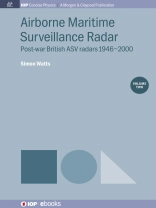Today, air-to-surface vessel (ASV) radars, or more generally maritime surveillance radars, are installed on maritime reconnaissance aircraft for long-range detection, tracking and classification of surface ships (ASu W—anti-surface warfare) and for hunting submarines (ASW—anti-submarine warfare). Such radars were first developed in the UK during WWII as part of the response to the threat to shipping from German U-Boats. This book describes the ASV radars developed in the UK after WWII (1946–2000) and used by the RAF for long-range maritime surveillance.
Inhoudsopgave
A Note on units Acknowledgements Author biography List of abbreviations 1.Introduction 1.1.ASV Radars 1.2.RAF Coastal Command and Strike Command 1.3.Research, Testing and Evaluation 1.3.1.Research and Development Establishments 1.3.2.Performance Assessment and Training 1.4.WWII ASV Radars 1.5.Post-war ASV Radar and Aircraft Developments 1.6.Summary of Book 1.7.References 2.ASV Mk. 7A 2.1.Introduction 2.2.ASV Mk. 7A Equipment 2.3.Radar Performance 2.3.1.Detection Ranges 2.4.Conclusions 2.5.References 3.ASV Mk. 13 3.1.Introduction 3.2.Proving trials of ASV Mk. 13 3.3.ASV Mk. 13 Radar Parameters 3.4.ASV 13 Equipment 3.4.1.Transmitter-Receiver TR 3523A 3.4.2.Modulator 1963.4.3.Oscillator Unit Type 231 3.4.4.Indicator Type 211 3.4.5.Amplifier Type A3644 3.4.6.Scanner Type 85 3.4.7.Motor Generator Type 48 3.5.Radar performance on the Warwick aircraft 3.6.Comparative trial with AN/APS-20 3.7.ASV Mk. 13 (ARI 5729) in the Shackleton MR1 and MR2. 3.7.1.Early operational assessment 3.7.2.Sector scanning 3.7.3.Further evaluation trials 3.8.Conclusions 3.9.References 4.ASV 21 4.1.Introduction 4.2.ASV 21 Radar 4.2.1.Overview 4.2.2.Modulator 4625 4.2.3.Transmitter-Receiver 4626 4.2.4.Scanner 4627 4.2.5.Synchronizer Electrical 4.2.6.Indicator Unit 4.2.7.Marker Unit (Bearing) 12382 4.2.8.Control Unit 4.2.9.Power Unit 4.2.10.Gyro Unit, Mk 5 4.3.ASV 21 Installations 4.4.ASV 21D 4.5.Radar Trials 4.5.1.Initial Operational Evaluation of ASV 21 4.5.2.Detection of submarine snorts on the Shackleton 4.5.3.ASV 21D in the High Level Surveillance Role 4.5.4.ASV 21D performance against Fast Patrol Boats 4.5.5.Detection of submarine snorts at high level 4.6.Modelled radar performance 4.7.Conclusions 4.8.References 5.ASR 846 Development 5.1.The Replacement for ASV 21D 5.2.Operational Requirements 5.2.1.Operational Environment 5.2.2.The need for radar 5.2.3.ASR 846 5.3.Potential radar solutions 5.3.1.ASV 21D 5.3.2.New radar techniques5.3.3.Comparison of performance 5.4.Radar Research 5.5.The Procurement Process5.6.Project Definition 5.7.Full Development 5.8.EMI Development Radar 5.9.References 5.10.Appendix, ASR 846 (Second Issue) 6.Searchwater6.1.The Searchwater Radar on Nimrod MR2 6.2.Radar parameters 6.3.Radar components 6.3.1.Antenna and scanner 6.3.2.Duplexer/Diplexer 6.3.3.Transmitter-Receiver System 6.4.Signal Processing 6.4.1.The RAD and CFAR control 6.4.2.WBI 6.4.3.DSCU 6.4.4.AGC 6.4.5.Target tracker 6.5.Radar Displays 6.6.Conclusion 6.7.References 7.Comparative Performance of ASV 21D and Searchwater 7.1.Radar performance prediction methods 7.2.Comparison of performance between Searchwater and ASV21D 7.3.Noise-limited performance 7.4.Clutter limited performance 7.5.Conclusions 7.6.References 8.Other ASV Radars 8.1.Introduction 8.2.ASV Mk. 19 8.2.1.ASB Mk. 19B, ARI 5838 8.2.2.Transmitter-Receiver, Type TR.3699 8.2.3.Amplifier A.3700 8.2.4.Synchronizing Unit Type 30 8.2.5.Control Unit Type 625 8.2.6.Auxiliary control unit Type 928 8.2.7.Scanning Unit Type 123 8.2.8.Indicator Unit CRT Type 101 8.2.9.Installation in a Fairey Gannet AS.1 8.3.AN/APS-20 8.4.References 9.Conclusion 9.1.ASV radar evolution 9.2.Searchwater 2000MR 9.3.References
Over de auteur
Simon Watts graduated from the University of Oxford in 1971, obtained an MSc and DSC from the University of Birmingham in 1972 and 2013, respectively, and a Ph D from the CNAA in 1987. He is author and co-author of more than 80 journal and conference papers, a book on sea clutter, and Airborne Maritime Surveillance Radar.












